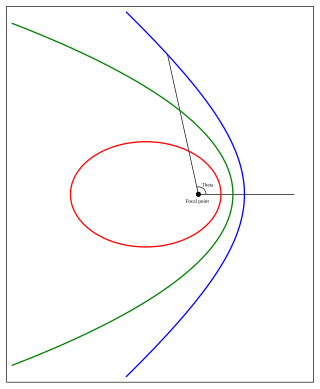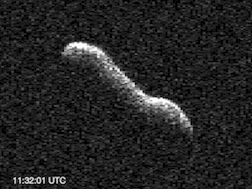In astronomy, absolute magnitude is a measure of the luminosity of a celestial object on an inverse logarithmic astronomical magnitude scale. An object's absolute magnitude is defined to be equal to the apparent magnitude that the object would have if it were viewed from a distance of exactly 10 parsecs, without extinction of its light due to absorption by interstellar matter and cosmic dust. By hypothetically placing all objects at a standard reference distance from the observer, their luminosities can be directly compared among each other on a magnitude scale. For Solar System bodies that shine in reflected light, a different definition of absolute magnitude (H) is used, based on a standard reference distance of one astronomical unit.
(35396) 1997 XF11 (provisional designation 1997 XF11) is a kilometer-sized asteroid, classified as a near-Earth object, Mars-crosser and potentially hazardous asteroid of the Apollo group.
4486 Mithra, is an eccentric asteroid and suspected contact-binary, classified as near-Earth object and potentially hazardous asteroid, approximately 2 kilometers in diameter. It belongs to the Apollo group of asteroids and is a relatively slow rotator.

In astrodynamics, the orbital eccentricity of an astronomical object is a dimensionless parameter that determines the amount by which its orbit around another body deviates from a perfect circle. A value of 0 is a circular orbit, values between 0 and 1 form an elliptic orbit, 1 is a parabolic escape orbit, and greater than 1 is a hyperbola. The term derives its name from the parameters of conic sections, as every Kepler orbit is a conic section. It is normally used for the isolated two-body problem, but extensions exist for objects following a rosette orbit through the Galaxy.
For most numbered asteroids, almost nothing is known apart from a few physical parameters and orbital elements. Some physical characteristics can only be estimated. The physical data is determined by making certain standard assumptions.
(292220) 2006 SU49, provisional designation 2006 SU49, is a sub-kilometer asteroid, classified as near-Earth object and potentially hazardous asteroid of the Apollo group that had a small chance of impacting Earth in 2029.
(179806) 2002 TD66 (also written 2002 TD66) is a sub-kilometer asteroid, classified as near-Earth object of the Apollo group. It was discovered on 5 October 2002, by the LINEAR project at Lincoln Laboratory's ETS in Socorro, New Mexico. It was announced on 7 October 2002 and appeared later that day on the JPL current risk page.

A minor planet is "lost" when today's observers cannot find it, because its location is too uncertain to target observations. This happens if the orbital elements of a minor planet are not known accurately enough, typically because the observation arc for the object is too short, or too few observations were made before the object became unobservable.
(5496) 1973 NA, is a very eccentric and heavily tilted asteroid, classified as near-Earth object of the Apollo group, approximately 2 kilometers in diameter. It was discovered on 4 July 1973, by American astronomer Eleanor Helin at the U.S. Palomar Observatory in California. At the time of its discovery, it was the most highly inclined minor planet known to exist. It may be the parent body of the Quadrantids.
(153814) 2001 WN5 is a sub-kilometer asteroid, classified as near-Earth object and potentially hazardous asteroid of the Apollo group.
(467336) 2002 LT38, is a sub-kilometer asteroid and suspected tumbler, classified as a near-Earth object and potentially hazardous asteroid of the Aten group, approximately 240 meters (790 ft) in diameter. It was discovered on 12 June 2002, by astronomers of the Lincoln Near-Earth Asteroid Research at the Lincoln Laboratory's Experimental Test Site near Socorro, New Mexico, in the United States.

(367789) 2011 AG5, provisional designation 2011 AG5, is a sub-kilometer asteroid, classified as near-Earth object and potentially hazardous asteroid of the Apollo group. It has a diameter of about 140 meters (460 ft). It was removed from the Sentry Risk Table on 21 December 2012 and as such it now has a rating of 0 on the Torino Scale. It was recovered in December 2022 extending the observation arc from 4.8 years to 14 years. As of 2023, the distance between the orbits of Earth and 2011 AG5 is 0.0004 AU (60,000 km; 0.16 LD)

367943 Duende (provisional designation 2012 DA14) is a micro-asteroid and a near-Earth object of the Aten and Atira group, approximately 30 meters (98 ft) in diameter. It was discovered by astronomers of the Astronomical Observatory of Mallorca at its robotic La Sagra Observatory in 2012, and named for the duende, a goblin-like creature from Iberian and Filipino mythology and folklore. Duende is likely an uncommon L-type asteroid and significantly elongated. For an asteroid of its size, it has a relatively long rotation period of 9.485 hours.
(471240) 2011 BT15, provisional designation 2011 BT15, is a stony, sub-kilometer sized asteroid and fast rotator, classified as a near-Earth object and potentially hazardous asteroid of the Apollo group. It had been one of the objects with the highest impact threat on the Palermo Technical Impact Hazard Scale.
In observational astronomy, the observation arc of a Solar System body is the time period between its earliest and latest observations, used for tracing the body's path. It is usually given in days or years. The term is mostly used in the discovery and tracking of asteroids and comets. Arc length has the greatest influence on the accuracy of an orbit. The number, spacing of intermediate observations, and timestamps have a lesser effect.

(66063) 1998 RO1 is a stony near-Earth object of the Aten group on a highly-eccentric orbit. The synchronous binary system measures approximately 800 meters (0.50 miles) in diameter. It was discovered by astronomers of the Lincoln Near-Earth Asteroid Research at the Lincoln Laboratory's Experimental Test Site near Socorro, New Mexico, on 14 September 1998.
2010 GZ60 was originally estimated by JPL to be a near-Earth asteroid approximately 2 kilometers (1.2 miles) in diameter. But is now known to be an asteroid from the inner region of the asteroid belt that does not get closer than 1.5 AU (220 million km) to Earth.
2013 GM3 is a micro-asteroid, classified as near-Earth object of the Aten group, approximately 20 meters in diameter. It was first observed on 3 April 2013, by astronomers of the Mount Lemmon Survey conducted at the Mount Lemmon Observatory near Tucson, Arizona, United States.
(385343) 2002 LV, provisional designation 2002 LV, is a stony asteroid on a highly eccentric orbit, classified as near-Earth object and potentially hazardous asteroid of the Apollo group, approximately 1.5 kilometers in diameter. It was discovered on 1 June 2002, by astronomers with the Lincoln Near-Earth Asteroid Research at the Lincoln Laboratory's Experimental Test Site near Socorro, New Mexico, in the United States. The Sr-type asteroid has a rotation period of 6.2 hours and is likely elongated.
2021 PH27 is a near-Earth asteroid of the Atira group. It was discovered by Scott Sheppard using the Dark Energy Survey's DECam imager at NOIRLab's Cerro Tololo Inter-American Observatory on 13 August 2021. 2021 PH27 has the smallest semi-major axis and shortest orbital period among all known asteroids as of 2021, with a velocity at perihelion of 106 km/s (240,000 mph). It also has the largest relativistic perihelion shift of any object orbiting the Sun, 1.6 times that of Mercury. With an absolute magnitude of 17.7, the asteroid is estimated to be larger than 1 kilometer (0.6 miles) in diameter.















